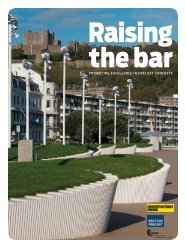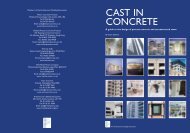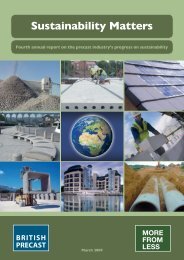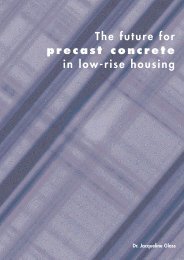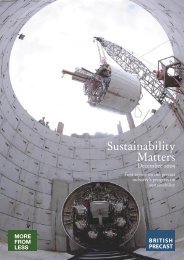The voice of concrete products - British Precast
The voice of concrete products - British Precast
The voice of concrete products - British Precast
Create successful ePaper yourself
Turn your PDF publications into a flip-book with our unique Google optimized e-Paper software.
PRECAST CONCRETE SPECIAL EDITION<br />
<strong>Precast</strong> <strong>concrete</strong> and 3D building information<br />
modelling – improving Britain’s schools<br />
“In applying 3D<br />
modelling<br />
technologies to<br />
the design and<br />
construction <strong>of</strong><br />
school buildings,<br />
the manufacturers<br />
<strong>of</strong> the <strong>concrete</strong><br />
components in<br />
these buildings<br />
stand to make<br />
significant<br />
productivity<br />
gains.”<br />
Figure 1: Fastbuild<br />
panels integrated with<br />
steel frame.<br />
<strong>The</strong> design and construction <strong>of</strong> school<br />
buildings can have a direct impact on<br />
the effectiveness <strong>of</strong> teaching and<br />
learning. In seeking to address this, the<br />
Government’s Building Schools for the<br />
Future (BSF) initiative <strong>of</strong>fers the chance<br />
for every local authority in England to<br />
renovate its secondary schools. It is<br />
enabling local authorities to move from<br />
‘patch and mend’ spending on schools to<br />
rebuilding and renewal, with a more<br />
strategic approach to everything from<br />
funding and procurement to the design<br />
and management <strong>of</strong> buildings.<br />
Andrew Bellerby, Tekla UK<br />
BSF is more than just a building programme. Its main<br />
aim is to create learning environments that inspire<br />
young people to reach their full potential and provide<br />
teachers with 21st Century workplaces, <strong>of</strong>fering access to<br />
facilities which can be used by all members <strong>of</strong> the local<br />
community. <strong>The</strong> programme is also committed to reducing<br />
the carbon emissions from schools, with all buildings making<br />
the most <strong>of</strong> sustainable features to help protect the<br />
environment and reduce overheads. Another key design<br />
issue is robustness, aiming for reduced levels <strong>of</strong> maintenance<br />
by using robust wall finishes for internal and external<br />
walls and ceilings.<br />
With ever more ambitious designs for buildings in the<br />
education sector making construction in this area more<br />
complex, manufacturers <strong>of</strong> the <strong>concrete</strong> components stand<br />
to make huge gains by adopting 3D building information<br />
modelling (BIM) practices. BIM can streamline the entire<br />
construction process, enabling every stage to be completed<br />
more efficiently, cost-effectively and on time, providing<br />
optimisation <strong>of</strong> structural solutions and consistent drawings<br />
and reports that contain full structural information. It’s<br />
what the industry expected CAD to be from the beginning.<br />
More than just CAD, BIM supports collaborative working<br />
between the different parties involved in a building project,<br />
including architects and designers, steel and <strong>concrete</strong><br />
detailers and manufacturers, structural engineers as well as<br />
contractors.<br />
Concrete in the construction <strong>of</strong> school buildings<br />
Concrete is an ideal material for use in the construction <strong>of</strong><br />
school buildings because <strong>of</strong> the specific design considerations<br />
that apply. Hard durable finishes, that require<br />
minimum maintenance, are important features for a new<br />
school. Internal and cladding walls are subject to harsh<br />
treatment and precast <strong>concrete</strong> walls have the advantage <strong>of</strong><br />
being able to withstand significant impact and water<br />
damage.<br />
Concrete is an excellent material for meeting the sustainability<br />
goals <strong>of</strong> the BSF initiative. Naturally good at<br />
moderating peak temperatures, <strong>concrete</strong> overcomes problems<br />
with summer overheating, which is already recognised<br />
as a problem for lightweight construction materials, and<br />
can overcome the need for air conditioning systems.<br />
Concrete also <strong>of</strong>fers further environmental efficiencies<br />
through superior acoustics, giving excellent sound insulation<br />
performance with minimum additional finishes<br />
required, making it the construction material <strong>of</strong> choice for<br />
today’s modern school buildings.<br />
Innovative approach to construction in the<br />
education sector<br />
Structherm is a Yorkshire-based building systems manufacturer,<br />
with over 20 years’ experience in the construction<br />
industry, specialising in insulated cladding systems. It has<br />
40<br />
Reproduced f ro m CONCRETE December 2008/January 2009 © <strong>The</strong> Concrete So c i e t y, 2008









